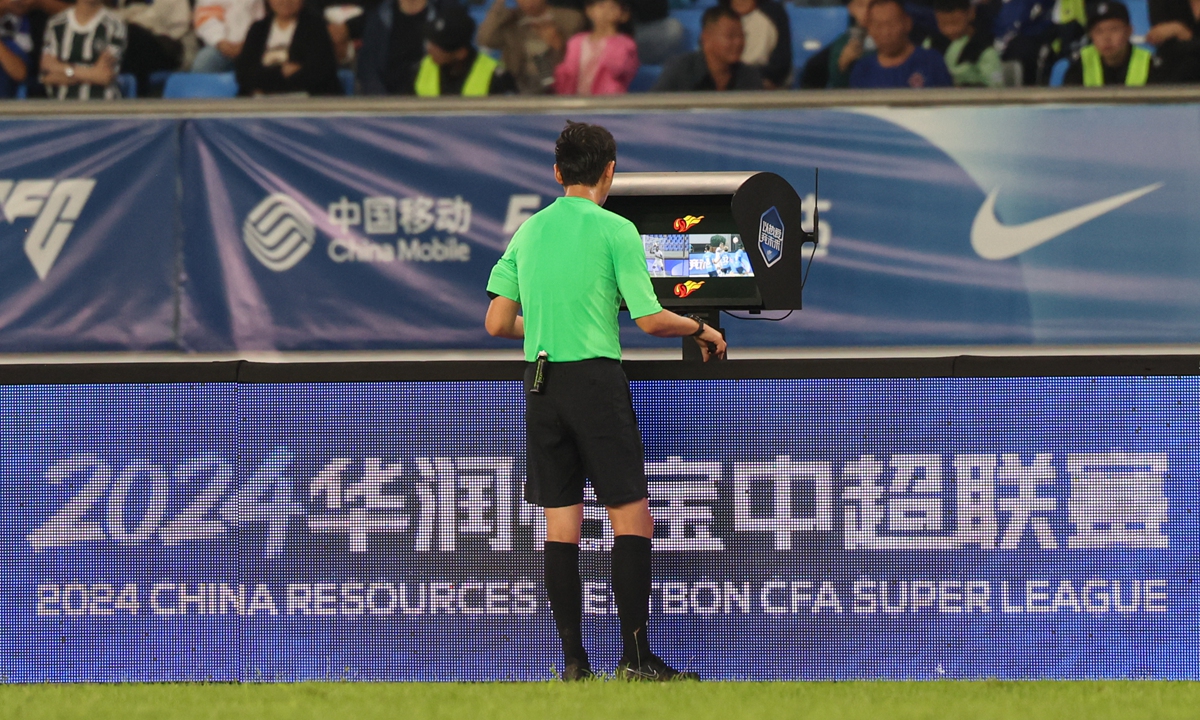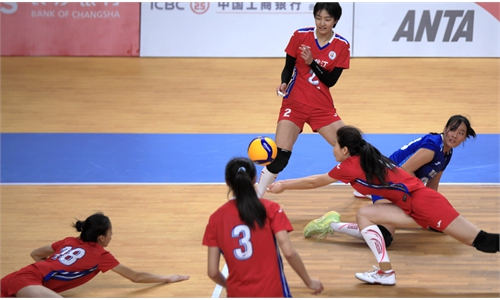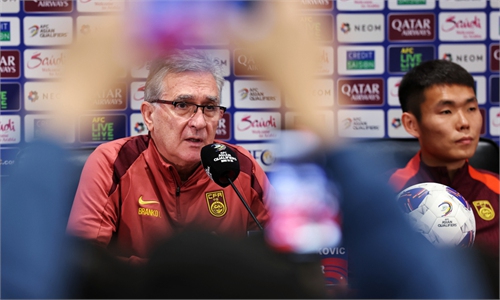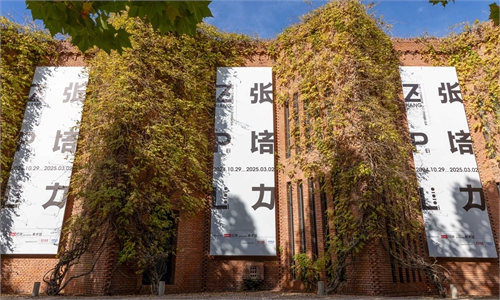ARTS / CULTURE & LEISURE
Advancements in AI for football and robot marathons
Enhancing sports

The referee views a pitchside monitor before making a decision during a football match in Cangzhou, North China's Hebei Province. Photo: IC
A new record was set in the Chinese Football Association Cup final on Saturday, with the debut of semi-automated offside detection technology on a Chinese football pitch."By installing 10 ultra-high-speed cameras in the stadium to track and capture 29 different key points on each player's body, the AI system automatically collects and processes the positioning data of both the ball and the players to assist in decision-making," a researcher involved in the development of intelligent football analysis system, who asked to remain anonymous, told the Global Times.
"The system automatically draws a virtual offside line; based on the touch feedback from the chip inside the ball, it determines the position and timing of the pass. Once the AI detects an offside situation, the system automatically alerts the referee," he said.
In the world of modern sports, the application of intelligent technologies is quietly reshaping traditional sporting landscapes.
Intelligent evolution
For the researcher, football is almost the best real-world research scenario where AI's ability to "break down" tasks and "collaborate" in different roles can be applied.
"AI can enhance the performance of football match analysis and evaluation models," he noted.
He explains that on the pitch, if we imagine the football field as a vast space filled with information points, even a world-class coach may only be able to grasp about 20 percent of the total information on the field. AI, therefore, needs to sift through this complex space, helping to extract key insights and assist coaches, players, and spectators in understanding the game more intricately.
Off the pitch, in the realm of game-theory-based intelligent decision-making for football, the researcher says that by leveraging vast amount of player and match data, a model like a parallel universe can be created for player behavior. This allows the fleeting moments of a football match to be rehearsed, replayed, and even predicted.
"Using a combination of virtual and real-world simulations along with parallel projections, to study football can effectively support pre-match training plans, real-time tactical adjustments during the game, and post-match reviews or reinforcement training. Of course, beyond football, this approach can also be applied to many other sports," he said.
In the past, every decision by a referee could spark either outrage or celebration among spectators, but now intelligent technology can effectively reduce the emotional reliance on such decisions. People will have more opportunities to focus on the game itself, whether it's the team's tactics or the individual performances of athletes.
Nowadays, more and more youth football tournaments are beginning to use intelligent football analysis systems. This shift is not only a technological advancement but also an improvement in educational philosophy.
"At the youth level, many players may not realize their own potential and shortcomings. Intelligent analysis data acts like a mirror, allowing them to see the real version of themselves," Hu Minghao, coach of a youth football club in Beijing, told the Global Times.
An ongoing trend
These days, the application of intelligent technology is not limited to football - it has become ubiquitous in the sports industry. In a striking display of technology meeting endurance, a humanoid robot joined over 9,000 runners at the Beijing E-Town Half Marathon in November. The robot, named Tien Kung, crossed the finish line acting as a "closing pacer," symbolizing a bold step in integrating intelligent robotics into sports.
It turns out that marathons are more than a challenge for human endurance - they are becoming fertile ground for testing and refining humanoid robots. "The marathon serves as a key project to test humanoid running postures and human-machine interaction," explained Zhang Qiang, chair of the Academic Committee for the National and Local Co-built Embodied Artificial Intelligence Robotics Innovation Center, and collaborative designer of Tien Kung.
This marathon appearance also explored the robot's speed limits in extreme scenarios. With an average speed of 10 kilometers per hour and a maximum running speed of 12 kilometers per hour, leading in its category, it can move smoothly across diverse terrains such as slopes, stairs, grass, gravel, and sand.

Humanoid robot Tien Kung Photo: Courtesy of Zhang Qiang
At the start of the race, Tien Kung stood on the sidelines, waving its arms to cheer on par-ticipants. Later, as a large group of runners approached the finish line, Tien Kung joined the race roughly 100 meters from the finish line, acting as a "closing pacer"to help athletes finish the race together.Marrying robotics with marathons is more than just technological experimentation. "It's a way to promote healthy living while showcasing the intersection of technology and humanity," Zhang said. The event highlights the potential for robots to engage meaningfully with the public, not merely as tools but as companions that foster curiosity and connection.
"Marathons offer a unique opportunity for humanoid robots to interact with people," Zhang noted, adding that this public engagement is key to demystifying robotics and promoting acceptance. Quoting Steve Jobs, Zhang said, "The best tech products lie at the intersection of technology and humanities. For humanoid robots, this principle is pivotal."
The roadmap extends beyond sports. Tien Kung's developers aim to refine its balance and interaction capabilities to conduct activities like badminton, tennis, and football. The ultimate goal is a human-centered approach, enabling robots to assist in diverse aspects of daily life.
In a move to accelerate innovation, Tien Kung's developers launched an open-source initiative on November 11. This global call aims to unite the world's brightest minds in robotics, transcending geographical barriers to collaboratively advance the field.
"At the time of the era, the open-source approach recognizes the unique advantages of each nation in artificial intelligence," Zhang explained. "Every country has outstanding talent, and we hope to bring the best minds together through this initiative. By transcending geographical barriers, we can collectively work toward realizing a shared dream."



